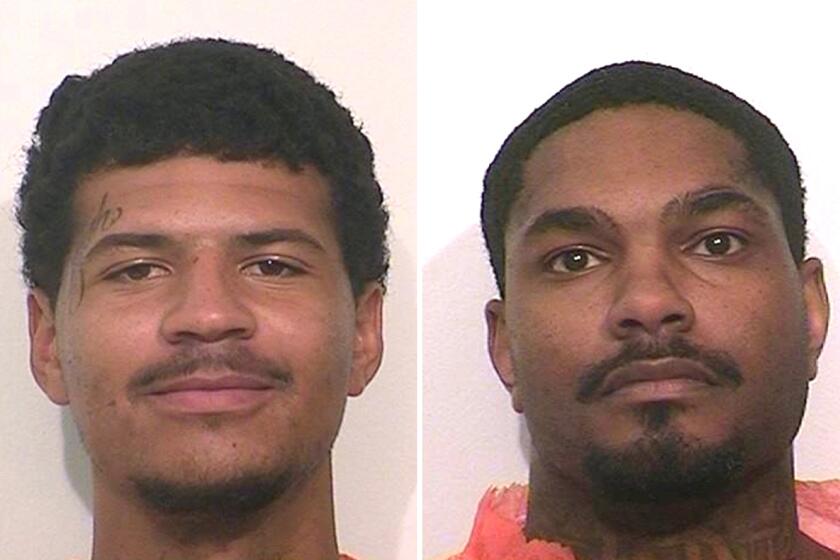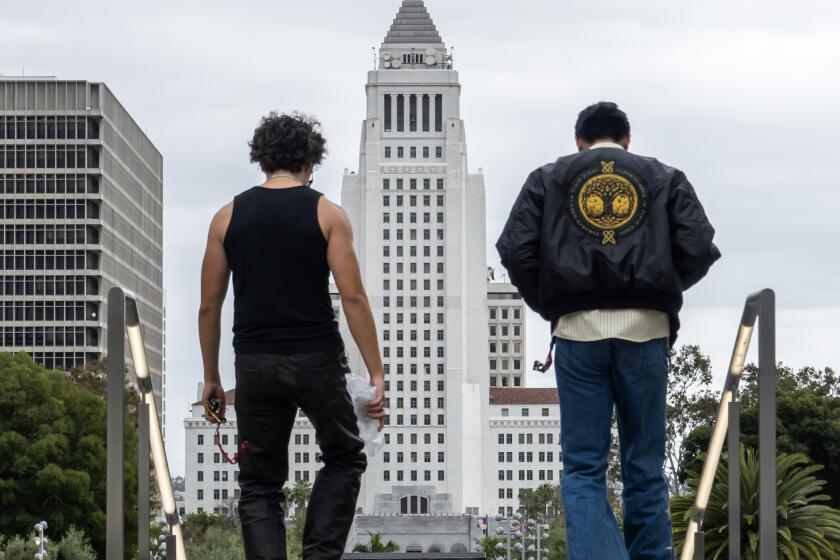Californian voters will decide on 10 state ballot measures. Study up!
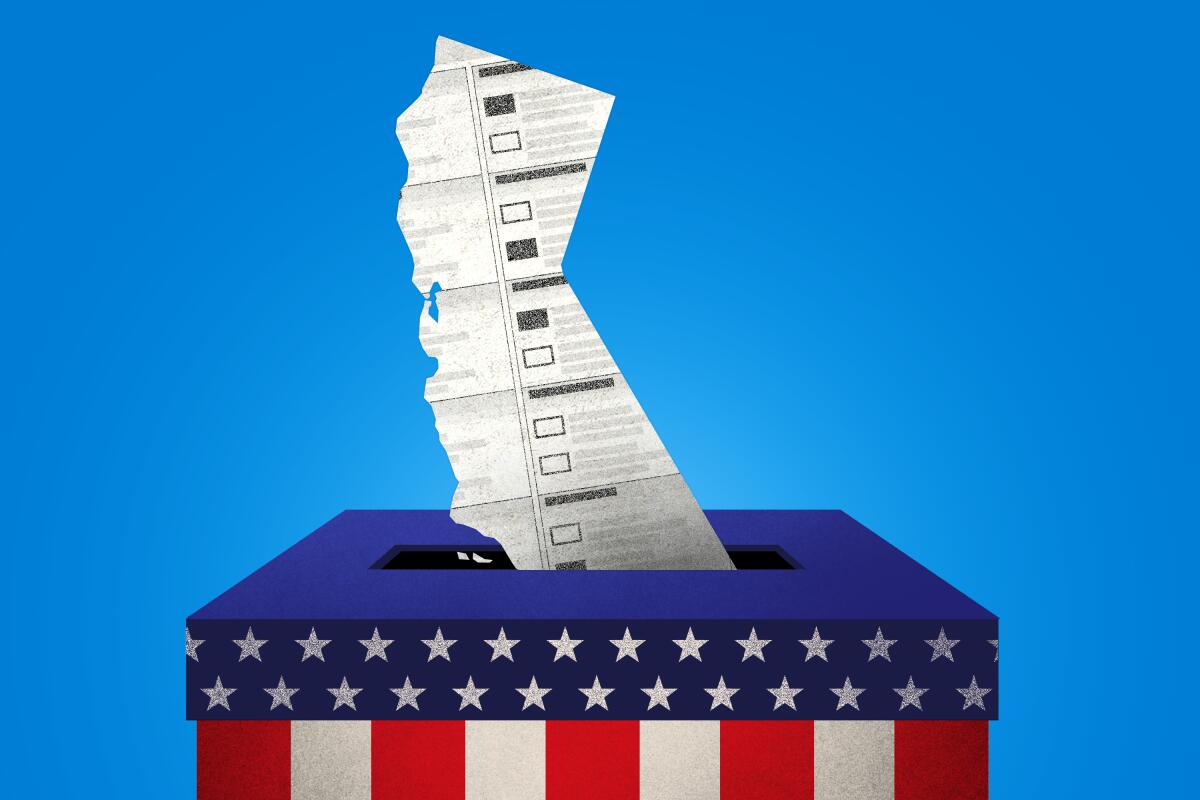
Good morning. It’s Wednesday, July 10. Here’s what you need to know to start your day.
- Read up on the state ballot measures California voters will decide in November
- Temperature records shattered across the West as intense heat wave drags on
- The best places to eat and drink in L.A. this month
- And here’s today’s e-newspaper
You're reading the Essential California newsletter
Our reporters guide you through our biggest news, features and recommendations every morning
You may occasionally receive promotional content from the Los Angeles Times.
Here’s direct democracy at work: 10 statewide ballot measures to read up on
We’re less than four months away from the November election. In California, that means voters will be staring at a long-ish ballot.
Ten statewide measures will be bringing key issues to voters, including raising the minimum wage to $18, imposing harsher sentences for drug possession and retail theft, banning forced labor in state prisons and removing local hurdles to affordable housing and transportation projects.
The Golden State’s trademark brand of direct democracy keeps us busy in election years — and this year could have been even busier without some late-inning legislative maneuvering.
“The number of ballot measures put to voters could have been much higher, but a flurry of last-minute negotiations in the state Capitol led to measure proponents agreeing to pull their proposals in favor of legislation,” Times reporter Mackenzie Mays wrote last week. “The remarkable round of deal making comes as state leaders have fought to tackle a massive budget deficit and worry about bogging down voters with a crowded ballot.”
Ten propositions still feels plenty crowded to me. But thankfully, The Times’s elections team has put together handy guides for each issue so we can study up. Here’s a crash course on a few of them to get you started.
Proposition 3 would reaffirm same-sex marriage in the state
Same-sex marriage is legal across the nation, but nobody told California’s Constitution.
The clause in question reads: “Only marriage between a man and a woman is valid or recognized in California.”
Prop. 3 would do away with that language and instead read: “The right to marry is a fundamental right.”
“While the constitutional clause is unenforceable, and same-sex marriage remains federally protected, proponents of the measure say it’s a necessary precaution in case of potential rulings from a conservative Supreme Court majority former President Trump helped appoint,” Mackenzie explained.
Proposition 4 would borrow $10 billion to fund climate and environmental projects
The so-called California Climate bond (because who has time to say the Safe Drinking Water, Wildfire Prevention, Drought Preparedness, and Clean Air Bond Act of 2024?) was designed in part to recoup funding for climate change-related programs that were slashed because of the state’s serious budget deficit.
The money would be used to pay for myriad efforts aimed at protecting communities from our increasingly volatile climate. That includes projects to provide safe drinking water, replenish groundwater, defend against flooding and wildfires, improve air quality and protect Californians from extreme, deadly heat.
“California taxpayers would pay the bond back with interest,” Times reporter Melody Petersen noted. “A legislative analyst estimated it would cost the state $650 million a year for the next 30 years or more than $19 billion.”
The measure has strong support from environmental, social justice and labor organizations, as well as the renewable energy companies and recycling industries — some of whom would see paydays from the funding.
The Howard Jarvis Taxpayers Assn. is opposed, saying projects should be funded without taking on debt and interest that makes them even costlier.
Proposition 36 would change parts of Proposition 47
That 2014 ballot initiative turned some nonviolent felonies into misdemeanors and gave us a decade’s worth of arguments about crime and punishment.
Under the proposed changes:
- A person’s third offense of theft, regardless of merchandise value, would become a felony punishable by up to three years in prison
- Possession of fentanyl would become a felony
- Three arrests for drug possession would trigger a “treatment-mandated felony”
Supporters of Proposition 36 include law enforcement leaders and an association of mostly conservative prosecutors, who say reducing fentanyl use and some types of theft requires stronger criminal penalties.
However, “criminal justice reform groups and human rights activists have been outspoken against altering Proposition 47, saying that it will lead to an increase in the state’s prison population and the associated costs,” Times reporter Anabel Sosa explained.
Proposition 32 would mandate an $18 hourly minimum wage for all Californians
For nearly a decade, the statewide minimum wage has sat at $16 an hour. Proposition 32 would increase that, building off recent wage increases in specific sectors, including $20 for fast food workers.
Under the proposal, all workers in the state would make at least $18 an hour by 2026, with wages rising at different times for different companies, based on the number of employees.
“While California’s minimum wage is among the highest in the country and more than twice as much as the federal requirement, many workers are still struggling with a skyrocketing cost of living,” Mackenzie wrote. “The current minimum wage pencils out to about $33,000 a year, and the average cost of living is about $53,082 a year, according to recent federal data.”
The initiative hasn’t garnered strong support from labor unions and anti-poverty advocates, some of whom believe it could undermine efforts to secure a $20 minimum wage that many organizations are striving for.
There’s clear opposition from the California Republican Party and business organizations, who argue that increasing wages will put more strain on companies and small businesses.
Here are guides to all the other measures state voters will decide on in November:
- Proposition 2: Education bond
- Proposition 5: Making it easier to pass local housing, road bonds
- Proposition 6: Ending forced prison labor
- Proposition 33: Effort to expand rent control
- Proposition 34: Effort to limit major healthcare group’s non-patient spending
- Proposition 35: Taxing managed care organizations
Today’s top stories
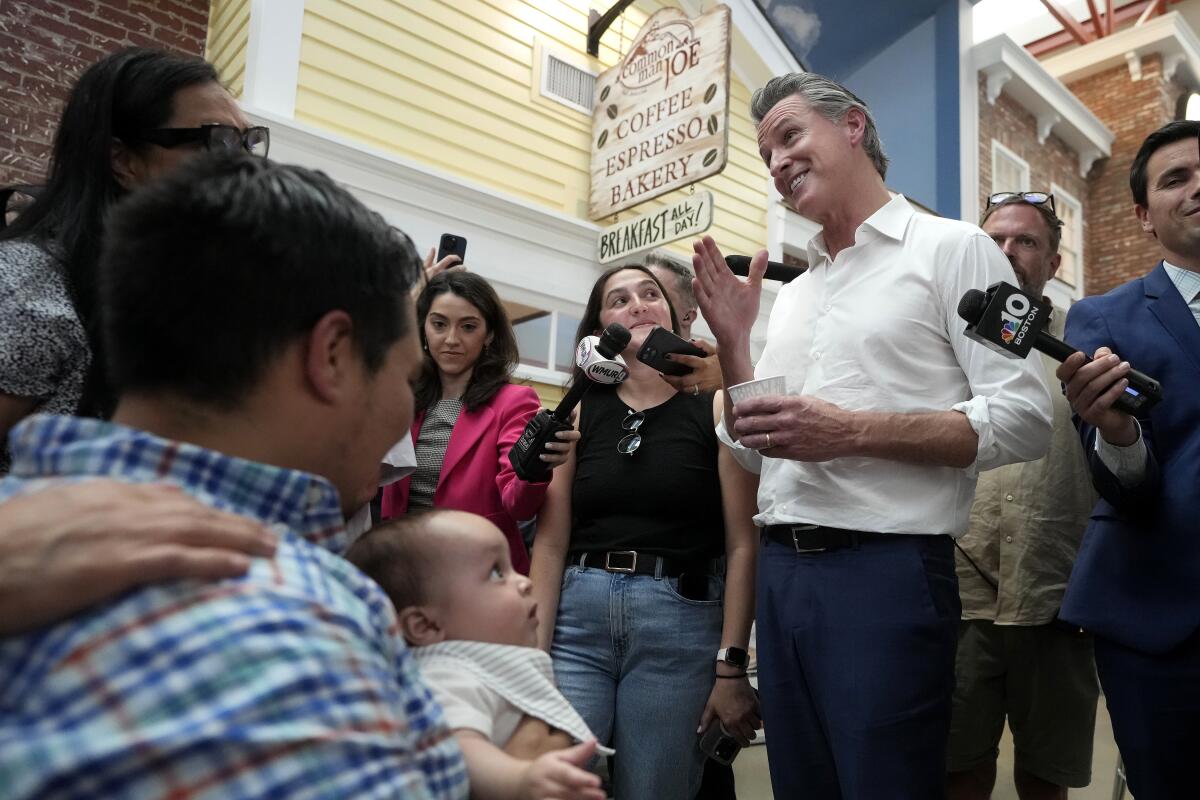
Politics
- Newsom on his swing-state tour to help Biden: ‘I pick up the fight.’
- Biden’s fate dominates global stage at NATO summit.
- Steve Garvey has been quiet since the March primary. So what was he doing in Israel?
- Four takeaways from the new Republican Party platform — or Trump’s playbook.
- Harris rallies in Las Vegas for Biden. Many Democrats agree, but some want her to face Trump.
Science and medicine
- ‘We’ve created medical refugees.’ LGBTQ+ healthcare workers fight for gender-affirming care amid rise in anti-trans laws.
- Should Biden take a cognitive test? Here’s what it would — and wouldn’t — tell us.
More big stories
- Temperature records shatter across the West as intense heat wave drags on.
- Wildfire destroys 13 homes in Northern California.
- The mouse gloves are off: Disney workers to vote on strike amid contract talks.
- Baroo, innovator of Korean dining, is The Times’ 2024 Restaurant of the Year.
- Murder, birth and test scores: What scientists are learning about extreme heat.
- In the fentanyl crisis, infants and toddlers become unsuspecting victims.
- L.A. crew targeted prominent New Zealand couple at Newport mall, ending in killing, D.A. says.
- Driver in fatal Malibu crash identified as 32-year-old social media influencer.
- ‘It’s bold’: L.A. moves to close Wilshire Boulevard through MacArthur Park.
- O.C. mosquito samples are West Nile-positive; that’s not the only danger pesky bloodsuckers pose.
- Pro-Palestinian groups sued over demonstration outside L.A. synagogue.
- Kroger discloses plan to sell 63 supermarkets in California as part of its merger with Albertsons.
Get unlimited access to the Los Angeles Times. Subscribe here.
Commentary and opinions
- Michael Hiltzik: A Trump judge blocks another pro-worker Biden initiative, this one involving noncompete clauses.
- Robin Abcarian: Who should replace President Biden if he leaves the race? The answer should be obvious.
- Mark Z. Barabak: It’s not just the White House. Biden could also cost Democrats control of Congress.
Today’s great reads

Grasshopper apocalypse? Why these farmers are bracing for an insect invasion. By mid-July, thousands of grasshoppers take flight, and can migrate several miles. In the fields, they are camouflaged and eat everything in their path. But when they’re out and about they become a nuisance in daily life. For instance, one can’t go outside without several crashing into your face.
Other great reads
How can we make this newsletter more useful? Send comments to [email protected].
For your downtime
Going out
- 💃🏽 South L.A.’s hottest dance party happens at ‘Granny’s house’ — and it feels revolutionary.
- 🍦The best places to eat and drink in L.A. this month, according to our food writers.
Staying in
- 📕Can Angelenos ever make sense of the gang killing of a baby? Jesse Katz answers that question in his latest book, “The Rent Collectors.”
- 🧑🍳 Here’s a recipe for summer herb meatballs with avocado dip.
- ✏️ Get our free daily crossword puzzle, sudoku, word search and arcade games.
And finally ... a great photo
Show us your favorite place in California! We’re running low on submissions. Send us photos that scream California and we may feature them in an edition of Essential California.
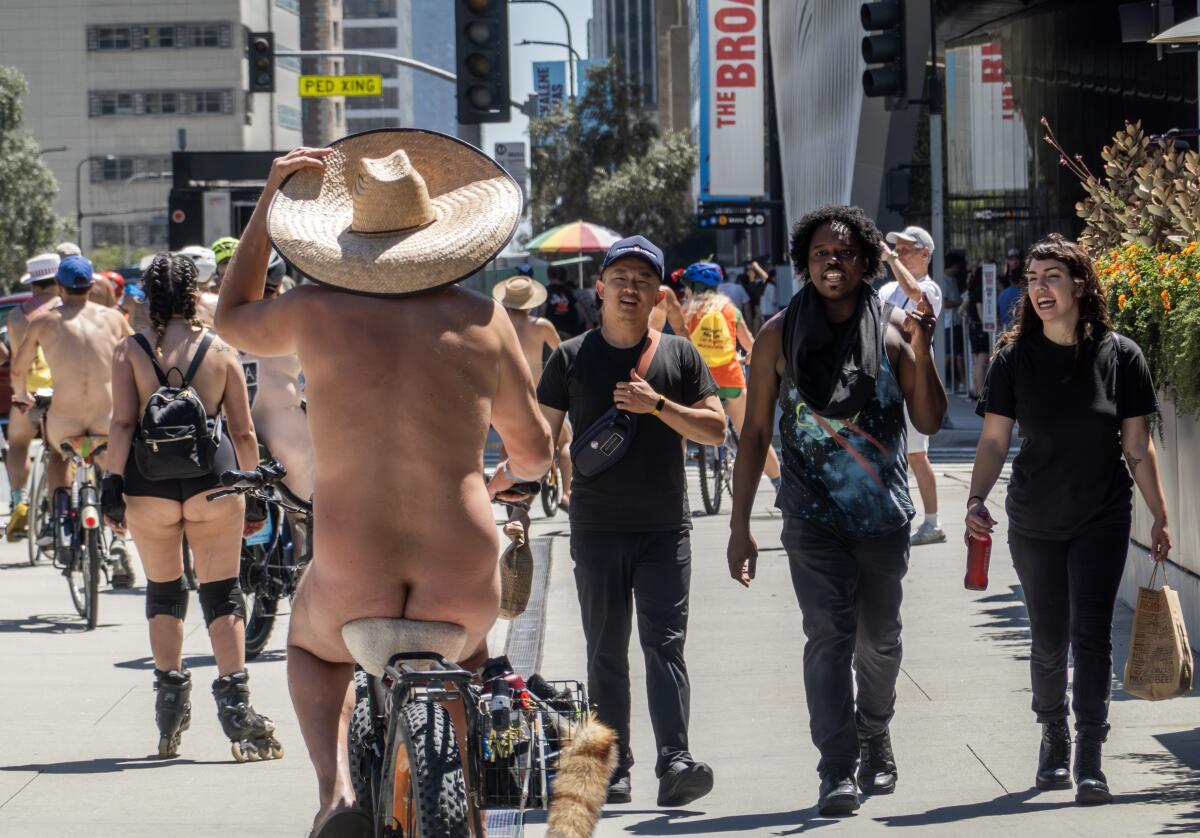
Today’s great photo is from Times photographer Myung J. Chun. World Naked Bike Ride participants roll through downtown L.A. on June 22.
Have a great day, from the Essential California team
Ryan Fonseca, reporter
Kevinisha Walker, multiplatform editor and Saturday reporter
Christian Orozco, assistant editor
Stephanie Chavez, deputy metro editor
Karim Doumar, head of newsletters
Check our top stories, topics and the latest articles on latimes.com.
Sign up for Essential California
The most important California stories and recommendations in your inbox every morning.
You may occasionally receive promotional content from the Los Angeles Times.



